Over 20 years ago I visited the Greek Island of Rhodes with my wife for a holiday, this year we decided to go back. We were thinking of staying in England, but with the weather being what it has been of late....we needed some sun. My birding activity was generally limited to walks around the resort of Kolymbia, where we stayed, but we did hire a car for a few days and were able to explore farther afield, something we did not do on our last time. The sites I visited were based on information gathered from the Fatbirder website, the link to it is here.
On reading that information it was apparent that April was the best month to visit the island, but that wasn't an option, so our trip was scheduled for mid May. My trips to eastern Turkey in May have been excellent and birds have still been on the move, so I was optimistic of seeing some migrants, whilst still mindful that this wasn't a birding trip. Rather than produce a day by day diary I have grouped my sightings under site headings as has been done on the Fatbirder site.
Appolakkia Reservoir
The incentive for visiting this site was that it was cited as the only deep and permanent freshwater that can be found on the island. Although according to the map we bought, the reservoir north of Ghadhoura Dam would also appear to be permanent freshwater, and larger, but we did not make it to this site. I have to admit that we arrived at the dam around lunchtime, so not the best time for birding, and that may explain the lack of birds recorded. On and around the reservoir we recorded little egrets, grey heron and little grebe, with long-legged buzzard, hobby, golden oriole, northern wheatear, eastern olivaceous and sardinian warbler and jay either overhead or in the nearby scrub. We didn't stay for more than an hour so with more time and at the right time of day the area could be more productive I am sure.
Kolymbia
Most of my birding was done on the headland to the north of the resort. To be honest there wasn't too much to see bird wise, other than the resident hooded crows, crested larks, Sardinian warblers, greenfinch's, linnets and goldfinch's. But on occasions there was a small passage of migrants with European bee-eaters recorded and occasional red-footed falcons passing through.
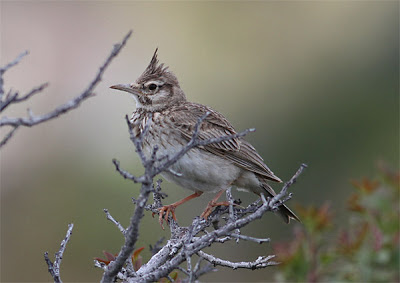 |
| Crested Lark Galerida cristata a resident species on the headland at Kolymbia |
Other species recorded included white wagtail, black-eared wheatear, common kestrel, raven, a squacco heron, which looked well out of place on a headland, and a flock of 10 little egrets. Hirundines were well represented with barn and red-rumped swallow, house and crag martin and common swift all recorded.
 |
| Common Raven Corvus corax recorded on two occasions on the headland |
With the bird life being fairly limited my attention was drawn to other species groups. The most notable moth species was what I presumed to be white-collar burnet, at least 20 were recorded daily feeding on nectar. This is not a species I had seen before and I note that there are several similar species, but white-collar seemed to be the most similar.
 |
| White-collar Burnet Zygaena carniolica |
There were plenty of reptiles to catch up with too, it is always fun trying to get a good shot. Starred agamas were numerous, not just on the headland near Kolymbia but at all the sites we visited around the island. This species is one that I have regularly encountered in Turkey where they vary greatly in colour...that was the case here on Rhodes too.
 |
| Starred Agama Laudakio stellio |
A species that was new to me was Lacerta oertzeni. I assumed that this individual was a Balkan wall lizard when I found it, but on checking with a reptile enthusiast mate, I was informed it was most likely L. oertzeni.
 |
| Larcerta (Antolalarcerta) oertzeni |
Apparently this species is not strictly a wall lizard (Podarcis) but belongs to the rock lizards, although in the Eastern Aegean it fulfils much the same ecological niche as wall lizards. A cracking beast whatever role it fulfils I think.
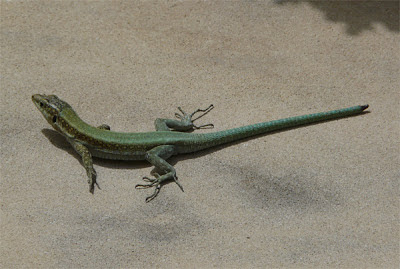 |
| Larcerta (Antolalarcerta) oertzeni |
Another species that was very common around the resort was Turkish gecko. Every time we got back to our room after dark, this species was all over the walls. They were surprisingly translucent and are easily identified since the adhesive pads do not extend to the tip of the toe.
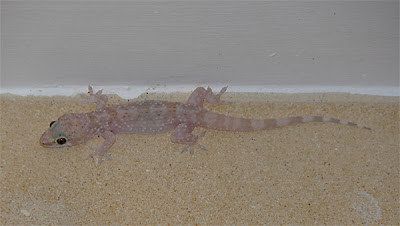 |
| Turkish Gecko Hemidactylus turcicus |
Kremasti
I was drawn to this site because there were previous report of a white-tailed plover and Baillon's crake here, admittedly that was a few years before and in April, but you never know. The site is located just north of the airport and before you arrive at the centre of the town. On arriving I immediately picked out a little stint in the middle of the river.
 |
| Little Stint Calidris minuta |
Several species of heron were also present, squacco was the most numerous, with seven recorded.
 |
| Squacco Heron Ardeola ralloides |
They were generally very confiding but occasionally birds would take flight, showing the contrasting white wing feathers. Grey and purple herons were also present and reed, Cetti's and eastern olivaceous sang from the scrub and reeds.
 |
| Squacco Heron |
Heading down stream I came across a cracking black-crowned night heron roosting in a nearby tree, but no sign of any crakes or plovers.
 |
| Black-crowned Night Heron Nycticorax nycticorax |
On the way back to our accommodation we stopped at an amazing species rich meadow. European bee-eaters, hoopoe, European turtle dove and woodchat shrike were present. But the highlight for me was a stunning cricket. It was predominantly dark in colouration, but with white and red patterning and a green ovipositor.
 |
| Poecilimon hamatus |
After a bit of research I was able to pin it down to Poecilimon hamatus. Apparently this species occurs in Turkey and on the Island of Rhodes only. It is quite different to other Orthoptera in that the female responds to the male acoustically. For more information check out the following link http://naturewonders.piwigo.com/picture?/1191
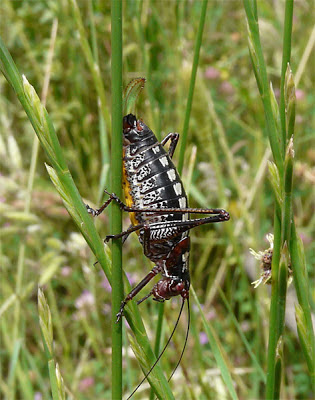 |
| Poecilimon hamatus |
I did manage to get a few pictures of some other Orthoptera but have not yet had the time to sort them out, so they will have to wait for another post.
Plimmyri and Southern Tip
The southern tip of the island was quite spectacular. It was much lusher than the northern half of the island, with more dense scrub and less development. Our first stop was Plimmyri; on arrival there did not seem to be much to see, but after a bit of effort I saw a couple of squacco herons, a great reed warbler, woodchat shrike, spotted flycatcher a very confiding eastern olivaceous warbler.
 |
| Eastern Olivaceous (Isabelline) Warbler Iduna opaca |
Black-headed buntings were relatively common and a male and female red-footed falcon hunted over the nearby fields. The usual Sardinian warblers and crested larks were as abundant as ever. Moving on we headed on to the southern tip of the island, the scenery was great and the crashing waves were very popular with wind surfers. The only new bird species of note was a cracking male black-headed wagtail.
After lunch we headed north up the western coast stopping at various view points on the way. At one stop I wandered off into the dunes and immediately stumbled across the remains of a dead turtle.
 |
Remains of a Turtle Species - Both Loggerhead Caretta caretta and Green Chelonia mydas turtles
breed in the Mediterranean, unfortunately it was not possible to identify the remains of this one |
Apparently, there are two species of turtle that breed in the Mediterranean, loggerhead and green. The loggerhead has been the subject on many studies in the Ionian Sea and its breeding success studied. One of the highest causes of mortality is fishing, but these remains were too old to look for any cause of death. The shell was at the highest point of the tide line, and could have just been washed in or the tide, or maybe this beach in the site of a small breeding colony and the turtle had rolled over whilst coming ashore.
 |
| Snake-eyed Lizard Ophisops elegans |
Another new species for me was snake-eyed lizard, so called because it has an unusual eye adaptation. Looking closely it is possible to see the unusually large and shiny appearance of the orbit.
 |
| Snake-eyed Lizard |
River Ghadhouras
I think that any of the river valleys are worth a look if you are travelling around, unfortunately I only had time to look at one. The River Ghadhouras is down stream of the aforementioned dam, and partly because of recent storms, and being fairly early in the year, there was still plenty of water and mud present.
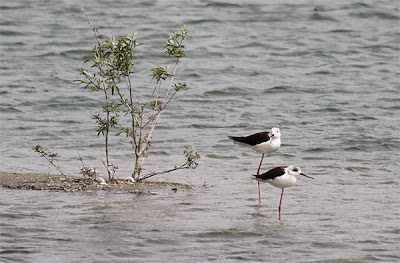 |
| Black-winged Stilt Himantopus himantopus |
I hadn't brought any sturdy footwear with me and parts of the river bed were quite muddy, nonetheless I was able to navigate my way through. Eastern olivaceous warblers were common, as were crested larks. Red-rumped swallows foraged overhead and a couple of stone curlew gave tantalising glimpses, but called frequently. Two wader species were present, three black-winged stilts and a sanderling, but despite extensive searching there were no other species. This area has previously supported little-ringed and ringed plover, wood, green and marsh sandpiper and collared pratincole...but not today.
 |
| Sanderling Calidris alba |
A broad scarlet or scarlet darter was the only species of dragonfly to settle long enough for me to photograph it.
 |
| Broad Scarlet Crocothemis erythraea |
A couple of European bee-eaters hunted from some overhead wires, one of them caught a large grasshopper (most likely an Egyptian grasshopper) and preceded to throw it in the air to break of all the legs before swallowing it....presumably just in case a sting was present.
 |
| European Bee-eater Merops apiaster playing with a large Grasshopper Species |
So despite this not been a birding trip, I was able to catch up with a few regular European bird species and some excellent reptiles and invertebrates. I have not had the time to add up the species tally but that was not really the point of the trip.





















